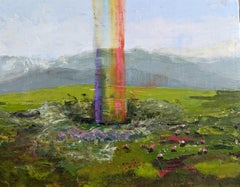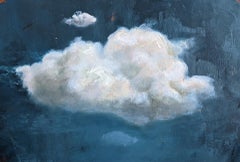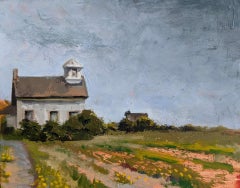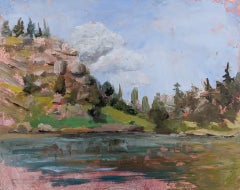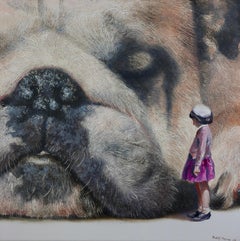Caitlin Hurd Art
to
4
10
1
2
Overall Width
to
Overall Height
to
13
1
6
5
2
1
1
1
13
13
4
4
3
13
7,763
4,946
2,504
1,371
13
Artist: Caitlin Hurd
"Rainbow Hole" Oil Painting
By Caitlin Hurd
Located in Denver, CO
Caitlin Hurd's (US based) "Rainbow Hole" is an original, handmade oil painting that depicts a wide open grass plain where mountains sway majestically in the background and a rainbow shoots straight into the blue sky from a hole in the ground.
About the Artist:
Born 1978, in Massachusetts, Caitlin Hurd grew up in Salem and the suburbs north of Boston. In 2000, she received a BFA in furniture design from The Minneapolis College of Art and Design. She went on to lead school-age children in the creation of public murals for their communities. In 2006, she graduated with an MFA in painting from The New York Academy of Art. In 2017 Hurd founded the Artists Off Grid Residency program. She is also the founder of Spark Portraits, where she paints commissioned oil portraits from photographs...
Category
2010s Surrealist Caitlin Hurd Art
Materials
Oil, Wood
Cloud
By Caitlin Hurd
Located in Denver, CO
Cloud, 2020
Category
21st Century and Contemporary Caitlin Hurd Art
Materials
Oil, Paper
Church as Vacation Home
By Caitlin Hurd
Located in Denver, CO
Church as Vacation Home, 2020
Category
21st Century and Contemporary Caitlin Hurd Art
Materials
Oil, Panel
View from the Nest
By Caitlin Hurd
Located in Denver, CO
View from the Nest
Category
21st Century and Contemporary Caitlin Hurd Art
Materials
Canvas, Oil
View From the Shed
By Caitlin Hurd
Located in Denver, CO
View From the Shed
Category
21st Century and Contemporary Caitlin Hurd Art
Materials
Canvas, Oil
Day at the Lake
By Caitlin Hurd
Located in Denver, CO
Day at the Lake
Category
21st Century and Contemporary Caitlin Hurd Art
Materials
Oil, Board
Landscape I
By Caitlin Hurd
Located in Denver, CO
Landscape I
Category
21st Century and Contemporary Caitlin Hurd Art
Materials
Oil, Board
Landscape II
By Caitlin Hurd
Located in Denver, CO
Landscape II
Category
21st Century and Contemporary Caitlin Hurd Art
Materials
Oil, Board
The Great Sand Dunes National Park
By Caitlin Hurd
Located in Denver, CO
The Great Sand Dunes National Park
Category
21st Century and Contemporary Caitlin Hurd Art
Materials
Oil, Wood
Bear I Am Afraid Of
By Caitlin Hurd
Located in Denver, CO
Bear I Am Afraid Of
Category
21st Century and Contemporary Caitlin Hurd Art
Materials
Oil, Canvas
Camp
By Caitlin Hurd
Located in Denver, CO
Camp
Category
21st Century and Contemporary Caitlin Hurd Art
Materials
Oil, Mylar
Up Hill
By Caitlin Hurd
Located in Denver, CO
Up Hill
Category
21st Century and Contemporary Caitlin Hurd Art
Materials
Oil, Mylar
Rainbow Valley
By Caitlin Hurd
Located in Denver, CO
Rainbow Valley
Category
21st Century and Contemporary Caitlin Hurd Art
Materials
Oil, Canvas
Related Items
Curious (black old dog, snout, lady, vintage, animal, surrealist oil painting)
By Rudolf Kosow
Located in Quebec, Quebec
"Curious," by Rudolf Kosow, is an engaging portrayal of inquisitiveness and wonder, bridging the natural world and humanity. Dominating the scene is a giant bulldog, its face a tapestry of textures from the soft fur to the glistening nose, each detail crafted to convey a lifelike presence.
Facing the monumental canine is a small-scale girl, her posture embodying the essence of childhood wonder as she stands before the immense animal. Her tilted head and attentive stance suggest a moment of mutual discovery and fascination. This poignant interaction is a snapshot of the innocent and pure connections that can occur across the divides of size and species.
Kosow's "Curious" captures the beautiful moments of discovery that occur when the young and the gentle giants of the animal kingdom meet, encapsulating a shared curiosity that transcends words. The artwork serves as a reminder of the universal language of wonder that connects us all.
keywords; painting on canvas, surrealist painting, animal vs human, americana, nature, man, man vs nature, surrealism, giant animal...
Category
2010s Surrealist Caitlin Hurd Art
Materials
Canvas, Oil
H 15.75 in W 15.75 in D 0.79 in
The Lily Pond
By William Baxter Closson
Located in Milford, NH
A fine impressionist landscape of a pond with lily pads by American artist William Baxter Closson (1848-1926). Closson was born in Thetford, Vermont, ...
Category
Early 20th Century American Impressionist Caitlin Hurd Art
Materials
Oil, Board
Australian American D. Rankin Abstract Expressionist Oil Painting Rocky Hillside
By David Rankin
Located in Surfside, FL
David Rankin, American (b. 1946)
Rocky Hillside, (1990)
Oil on paper
Hand signed lower right, signed and titled verso.
30 x 22 1/2 inches
David Rankin is a New York-based, British-born Australian post-war and contemporary artist known for his expressionistic abstract paintings. His work can be categorized by his use of quick, loose brushstrokes, reminiscent of scribbles on a page. Rankin works predominantly in oil painting and acrylic on canvas, but also works with paper, prints, sculptures and ceramics. Rankin has held over 100 one-person exhibitions in cities across the world, including New York, London, Paris, Beijing, Mexico, Vienna, Berlin and Cologne, as well as all over Australia. Represented in many of the world’s leading public and private collections and museums, David Rankin’s work is featured in Australia’s leading institutions, including the National Gallery of Australia, Art Gallery of New South Wales, National Gallery of Victoria and Queensland Art Gallery.
David Rankin was born in Plymouth, Devon, England in 1946 then emigrated to Australia with his family in 1948. He spent his childhood in the 1950s in the semi-rural Port Hacking region South of Sydney and his teenage years in country New South Wales, from Hay, Wagga Wagga and Albury in the South to Bourke and Brewarrina in the North.
Rankin is self-taught, developing his techniques and ideas in the outback towns of his youth. He was inspired by the greats from Leonardo da Vinci to Paul Klee as well as being influenced by the history of Buddhism and Asian art. In his travels before he arrived in Sydney in 1967 he developed a concept of what he wanted to achieve as an Australian artist. His dream was to express the anima, the life spirit or the essence of God in all nature. As an Australian artist he believed could bring the elements of Western Art together with an understanding and love for the cultures of Asia and the Australian Aborigine. He also felt that as Australia was closer to Asia than Europe it made sense to think about the art of Indian, Chinese and Japanese artists, and that one could not be an authentic articulate Australian artist without a love and respect for the artistic and spiritual expressions of the various Aboriginal artists, peoples and cultures. His work combined elements of Abstract Expressionist painting with Jewish and Aboriginal influences.
In 1979 his first wife, Jennifer Mary Roberts (née Haynes) died. Rankin subsequently met his current wife Lily Brett, whose own life was etched by tragedy with her parents being survivors of the Holocaust. She too migrated to Australia as a child after the Second World War in 1948. The artist recounts that his empathy for Lily and the pity for his first wife's death fused into what he calls "the dark blessing of my life." The darkness was transformed into images. The author Dore Ashton writes that the events of 1979 and the fire which ravished his studio in 1997 and burnt his art works and many personal possessions, had a profound impact on his work.
Having personal life experiences as his subject matter, Rankin's paintings contemplate these things. For example, his Jerusalem series followed a trip to Jerusalem in 1988, which then led to his Golgotha works. His travels to the Australian, American and Mexican deserts became the subject matter for many of his canvases, such as Ridge – Mungo, Golden Prophecy – San Antonio, Grey Sonora Landscape and then led to his Witness Series. From the fire in his studio he then painted Buddha and Flames. He illustrated two books by Lily Brett on the holocaust and explored the theme further in his huge work The Drowned and The Saved from a book by Primo Levi of the same name. Through Brett he encountered Jewish mythology and painted judaica imagery, Black...
Category
1990s Abstract Expressionist Caitlin Hurd Art
Materials
Oil, Paper
At Larchmont
By Hayley Lever
Located in Milford, NH
A fine impressionist oil marine sailing painting by Australian American artist Hayley Lever (1876-1958). Lever was born in Adelaide, Australia and studied first at the Adelaide’s Pri...
Category
Early 20th Century American Impressionist Caitlin Hurd Art
Materials
Oil, Board
Landscape in Souhegan Valley, NH, Probably Wilton
By Chauncey Foster Ryder
Located in Milford, NH
A fine impressionist landscape in the Souhegan Valley of New Hampshire, probably Wilton, by American artist Chauncey Foster Ryder (1868-1949). Ryder grew up in New Haven, Connecticut...
Category
Early 20th Century American Impressionist Caitlin Hurd Art
Materials
Oil, Wood Panel
Portrait of a Lady in an Elaborate Ruff & Lace Coif c.1610-20, Dutch Old Master
Located in London, GB
This magnificent oil on panel portrait, presented by Titan Fine Art, is a splendid example of the sumptuous female portraits that were painted for members of the upper echelons of society during the early part of the 1600’s. The artist has rendered this portrait with meticulous attention to detail and the surface effects of the fine materials. The elaborate lace coif and cuffs are painstakingly delineated, as is the bold black damask, and sumptuous gold decoration of her skirt and stomacher, which is wonderfully preserved and quite remarkable considering the age of the work and the fact that darker pigments are particularly vulnerable to fading and wear. This work with its spectacular depiction of costume is of absolute quality, it can be rated as one of the best works in the artist’s oeuvre and as such it is an important and splendid example of Dutch portraiture.
The Dutch Golden Age of painting was a period in Dutch history, roughly spanning the 17th century, in which Dutch trade, science, military, and art were among the most acclaimed in the world. Dutch explorers charted new territory and settled abroad. Trade by the Dutch East-India Company thrived, and war heroes from the naval battles were decorated and became national heroes. During this time, The Dutch Old Masters began to prevail in the art world, creating a depth of realistic portraits of people and life in the area that has hardly been surpassed. The Golden Age painters depicted the scenes that their discerning new middleclass patrons wanted to see. This new wealth from merchant activities and exploration combined with a lack of church patronage, shifted art subjects away from biblical genres.
Dress was a key component in portraits, and the exuberant attire reiterates the incredible wealth of this woman. The sitter will have visited the artist’s workshop and inspected examples on display. They would have chosen the size and the sort of composition and on that basis negotiated the price – which would have also been determined by the complexity of the clothing and the jewels that were to be depicted, and by the materials to be used. When all was considered, this portrait would have cost the sitter (or her husband) a substantial sum.
The colour black was regarded as humble and devout yet at the same time refined and sophisticated and the most expensive colour of fabric to dye and to maintain. Citizens spent fortunes on beautiful black robes. Such uniformity must also have had a psychological side-effect and contributed to a sense of middle-class cohesion; the collective black of the well-to-do burgess class will have given its members a sense of solidarity. The colour was always an exciting one for artists and when this portrait was painted there were at least fifty shades of it, and as many different fabrics and accoutrements. Artists went to great lengths to depict the subtle nuances of the colour and the fabrics and textures and how they reflected light and it was an ideal background against which gold and crisp white lace could be juxtaposed to dramatic effect.
The sitter is either a married women or a widower as is evident by the clothing that she wears and the position, toward her right, it is highly likely that this portrait was once a pendant that hung on the right-hand side of her husband’s portrait as was convention at the time. She wears a vlieger which was a type of sleeveless over-gown or cape worn by well-to-do married women in the late 16th and early 17th centuries. Variations with short sleeves or high shoulder rolls are known. Sometimes sleeves were attached with aiglets, and often slits were made to allow belts or the hands to pass through. Three-piece vlieger costumes of this kind were standard items of clothing in portraits of the women of the civic elite in the period 1600-40 and was a variant of the Spanish ‘ropa’ and served as a trademark of well-to-do married burgher women. Girls and unmarried woman, including beguines, wore a bouwen (a dress with a fitted bodice and a skirt that was closed all round) instead. This clear distinction between apparel for married and unmarried women is clear not only from inventories and trousseau lists, but also from contemporary sources such as the Dutch Spanish dictionary published by Juan Rodrigues in 1634. In it, a bouwen is described as a ‘ropa de donzella’ (over-gown worn by a virgin) and a vlieger as a ‘ropa de casada’ (overgown worn by a married woman). It is striking how few women are depicted wearing a bouwen, unless they are part of a group, family or children’s portrait and it can therefore be assumed that independent portraits of unmarried women were seldom commissioned. It is also believed that the clothing worn in these portraits existed and were faithfully reproduced when cross-referenced with the few exact documents. These sources also demonstrate that clients wanted their clothing to be depicted accurately and with this in mind precious garments and jewels were often left in the painter’s studio.
The prominent white lawn molensteenkraag (or millstone ruff) is held up by a wire supportasse and was reserved only for the citizens that could afford this luxurious item that often required 15 meters of linen batiste. The fabulous wealth of this sitter is also evident by the elaborate lace coif and cuffs which have been exquisitely depicted; lace was often literally copied by artists in thin white lines over the completed clothing.
The gold bracelet with jewels is a type that was evidently fashionable as it is seen in a number of portraits during the 1610s and 1620. Clothing and jewellery were prized possessions and were often listed in inventories of estates and passed down from generation to generation. There were a great number of jewellers of Flemish origin working at all the courts and cities of Europe, competing with the Italians, and then the French, adapting themselves to the tastes and positions of their patrons and the raw materials available in the country where they worked. The fashion for jewels “in the Flemish style” succeeded that of the Italian style.
Cornelis van der Voort, who was probably born in Antwerp around 1576, came to Amsterdam with his parents as a child. His father, a cloth weaver by trade, received his citizenship in 1592. It is not known who taught the young Van der Voort to paint, but it has been suggested that it was either Aert Pietersz or Cornelis Ketel. On 24 October 1598 Van der Voort became betrothed to Truytgen Willemsdr. After his first wife’s death he became betrothed to Cornelia Brouwer of Dordrecht in 1613. In addition to being an artist, Van der Voort was an art collector or dealer, or both. In 1607 he bought paintings from the estate of Gillis van Coninxloo, and after an earlier sale in 1610 a large number of works he owned were auctioned on 7 April 1614. Van der Voort is documented as appraising paintings in 1612, 1620 and 1624. In 1615 and 1619 he was warden of the Guild of St Luke. He was buried in Amsterdam’s Zuiderkerk on 2 November 1624, and on 13 May 1625 paintings in his estate were sold at auction.
Van der Voort was one of Amsterdam’s leading portrait painters in the first quarter of the 17th century. Several of his group portraits are known. It is believed that he trained Thomas de Keyser (1596/97-1667) and Nicolaes Eliasz Pickenoy (1588-1650/56). His documented pupils were David Bailly (c. 1584/86-1657), Louis du Pré...
Category
17th Century Old Masters Caitlin Hurd Art
Materials
Oil, Wood Panel
H 44.89 in W 35.83 in D 2.37 in
"Rasp" Contemporary Abstract Magenta & White Ombre Concentric Shaped Painting
Located in Houston, TX
Magenta and white abstract contemporary concentric shaped painting by Houston, TX artist David Hardaker. Signed, titled, and dated by the artist on the reverse.
Artist Statement: Th...
Category
2010s Contemporary Caitlin Hurd Art
Materials
Oil, Panel
"Chisel" Contemporary Abstract Magenta Ombre Shaped Concentric Oval Painting
Located in Houston, TX
Magenta and white abstract contemporary concentric oval shaped painting by Houston, TX artist David Hardaker. Signed, titled, and dated by the artist on the reverse.
Artist Statemen...
Category
2010s Contemporary Caitlin Hurd Art
Materials
Oil, Panel
Blow Pop - original hyperrealistic still life oil painting - contemporary art
Located in London, Chelsea
"Blow Pop" by Vita Kobylkina is an exquisite oil on board painting that transforms an everyday object into a work of art with a captivating blend of realism and contemporary pop art....
Category
21st Century and Contemporary Impressionist Caitlin Hurd Art
Materials
Oil, Board
Surreal Temple Stairs, Geometric Architecture Diptych, Blue and Yellow Landscape
By Natalia Roman
Located in Barcelona, ES
These series of paintings by Natalia Roman gather their inspiration from geometric, minimalist shapes and paintings from the beginning of Modernism, with a special emphasis on Art De...
Category
2010s Constructivist Caitlin Hurd Art
Materials
Oil, Acrylic, Archival Paper
Miracle (yellow banana couple surrealist oil painting comical vintage figurative
By Rudolf Kosow
Located in Quebec, Quebec
In "Case", banal, everyday things meet in this painting to create an unusual, strange, absurd and ironical situation derived by the disproportional scale size of things.
keywords;...
Category
2010s Surrealist Caitlin Hurd Art
Materials
Oil, Canvas
H 43.31 in W 37.41 in D 0.79 in
Poppy Fields
By Dennis Sheehan
Located in Milford, NH
A fine tonalist landscape of poppy fields with a single figure walking by contemporary American artist Dennis Sheehan (b. 1950). Sheehan was born in Boston, Massachusetts and went on...
Category
Late 20th Century Tonalist Caitlin Hurd Art
Materials
Canvas, Oil
Caitlin Hurd art for sale on 1stDibs.
Find a wide variety of authentic Caitlin Hurd art available for sale on 1stDibs. If you’re browsing the collection of art to introduce a pop of color in a neutral corner of your living room or bedroom, you can find work that includes elements of blue and other colors. You can also browse by medium to find art by Caitlin Hurd in oil paint, paint, canvas and more. Much of the original work by this artist or collective was created during the 21st century and contemporary and is mostly associated with the Surrealist style. Not every interior allows for large Caitlin Hurd art, so small editions measuring 9 inches across are available. Customers who are interested in this artist might also find the work of Peter Ellenshaw, Patrick Soper, and Piotr Butkiewicz. Caitlin Hurd art prices can differ depending upon medium, time period and other attributes. On 1stDibs, the price for these items starts at $640 and tops out at $7,100, while the average work can sell for $1,200.
Artists Similar to Caitlin Hurd
Questions About Caitlin Hurd Art
- Why is Peter Hurd famous?1 Answer1stDibs ExpertJanuary 27, 2025Peter Hurd is famous because of his landscape paintings depicting the American West and beyond. The landscape of New Mexico particularly inspired Hurd, and it was where he developed his artistic style. Hurd became celebrated for egg tempera, watercolors and lithographs. It was often from his field sketches that Hurd created his detailed tempera and watercolor pieces. Hurd’s adventurous spirit also took him all over the world, including in the mid-1940s when Hurd left home to serve as an illustrative war correspondent for LIFE magazine. The resulting wartime works varied from field sketches to fully developed egg tempera and watercolor works. Many of these war sketches now hang in the Pentagon. Find a selection of Peter Hurd art on 1stDibs.
